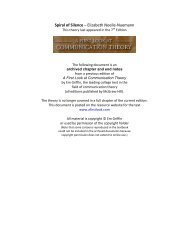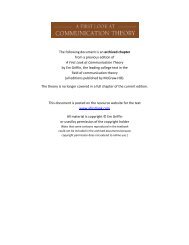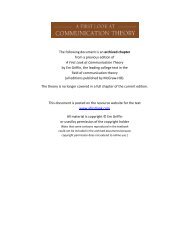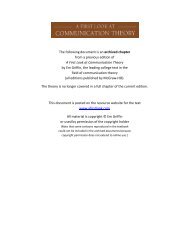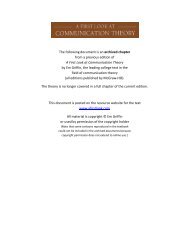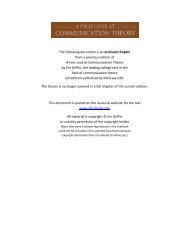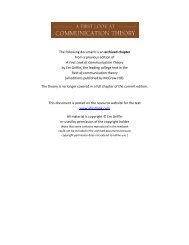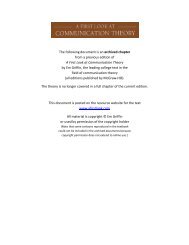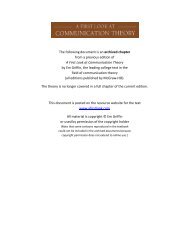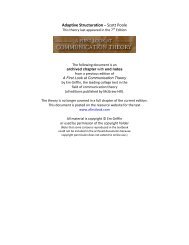Attribution Theory of Fritz Heider - A First Look at Communication ...
Attribution Theory of Fritz Heider - A First Look at Communication ...
Attribution Theory of Fritz Heider - A First Look at Communication ...
Create successful ePaper yourself
Turn your PDF publications into a flip-book with our unique Google optimized e-Paper software.
ATTRIBUTION THEORY 143<br />
This extended account <strong>of</strong> judgment may give you the impression th<strong>at</strong><br />
<strong>at</strong>tribution is a prolonged, conscious deliber<strong>at</strong>ion which takes place only in<br />
formal settings <strong>of</strong> guilt or innocence. Not so. Causal inferences are usually<br />
subconscious snap judgments made whenever we see others in action, Our<br />
judgments deal with praise as well as blame. <strong>Heider</strong>’s theory has gener<strong>at</strong>ed<br />
thousands <strong>of</strong> studies th<strong>at</strong> blanket the map <strong>of</strong> interpersonal rel<strong>at</strong>ions. One <strong>of</strong><br />
the fascin<strong>at</strong>ing extensions <strong>of</strong> the theory is the work <strong>of</strong> Cornell University<br />
psychologist Daryl Bern, who is interested in the way we look <strong>at</strong> our own<br />
actions.<br />
SELF-PERCEPTION: A SPECIAL CASE OF ATTRIBUTION<br />
Bern is concerned with the dispositional labels we assign to ourselves. He<br />
claims we don’t have favored st<strong>at</strong>us when it comes to figuring out our own<br />
prevailing moods. Our weak internal signals may give clues to our <strong>at</strong>titudes<br />
or emotions, but behavior is the acid test th<strong>at</strong> confirms or rejects our intuition.<br />
So we w<strong>at</strong>ch ourselves act and then draw conclusions about our inner dispo-<br />
sition just like outside observers do.<br />
Conventional wisdom suggests th<strong>at</strong> behavior follows <strong>at</strong>titude: “I play<br />
tennis because I like it.” Bern’s radical behaviorism says it works the other<br />
way around: “I like tennis because I play it.” L<strong>at</strong>er in the book we’ll see th<strong>at</strong><br />
cognitive dissonance theory also predicts th<strong>at</strong> actions precede <strong>at</strong>titude, but<br />
Bern explains the sequence on the basis <strong>of</strong> self-perception. We see ourselves<br />
put a dollar in a beggar’s cup and decide th<strong>at</strong> we are compassion<strong>at</strong>e.<br />
Emotions work the same way. You might think it’s safe to assume th<strong>at</strong> a<br />
fellow knows when he is sexually aroused. Not necessarily, according to<br />
Bern. He cites a study by Stuart Valins, a research psychologist <strong>at</strong> the St<strong>at</strong>e<br />
University <strong>of</strong> New York (SUNY) <strong>at</strong> Stony Brook. College men were wired<br />
with fake electrodes th<strong>at</strong> supposedly picked up their heartbe<strong>at</strong> and amplified<br />
it through a speaker for them to hear. The experimenter occasionally varied<br />
the bogus bi<strong>of</strong>eedback as the males looked <strong>at</strong> pictures <strong>of</strong> nude women. The<br />
men reported being most “turned on” by the photos th<strong>at</strong> were associ<strong>at</strong>ed<br />
with a change in heartbe<strong>at</strong>.<br />
Some cynic has suggested th<strong>at</strong> love is a feeling you feel you’re feeling<br />
when you feel you’re feeling a feeling. The st<strong>at</strong>ement is consistent with Bern’s<br />
description <strong>of</strong> self-<strong>at</strong>tribution. We aren’t sure wh<strong>at</strong> we feel, so we look to<br />
behavioral clues to fill in the gaps. “It must be love cuz my heart skipped a<br />
be<strong>at</strong>.”<br />
CRITIQUE: RENDERING A VERDICT<br />
<strong>Heider</strong> suggested th<strong>at</strong> people system<strong>at</strong>ically evalu<strong>at</strong>e causes <strong>of</strong> behavior in a<br />
commonsense search to understand why things happen. If <strong>Heider</strong> was right,<br />
however, some <strong>of</strong> the jurors Jean was with failed to get the message. After ten<br />
days <strong>of</strong> bickering, nine were convinced <strong>of</strong> the defendants’ guilt; three saw



